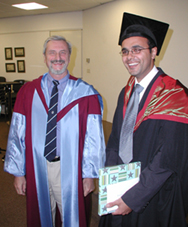Flexibility/Stiffness Techniques Applied to BEM Formulations
 The MPhil viva of George Samir Salem has recently taken place at Wessex Institute of Technology on his research on ‘Flexibility/Stiffness Techniques Applied to BEM Formulations’, which was funded by the EPSRC. The external examiner of the thesis was Prof Stavros Syngellakis from the University of Southampton, with Dr Robert Adey, Head of the Industrial Research Division of Wessex Institute of Technology as the internal.
The MPhil viva of George Samir Salem has recently taken place at Wessex Institute of Technology on his research on ‘Flexibility/Stiffness Techniques Applied to BEM Formulations’, which was funded by the EPSRC. The external examiner of the thesis was Prof Stavros Syngellakis from the University of Southampton, with Dr Robert Adey, Head of the Industrial Research Division of Wessex Institute of Technology as the internal.
George developed a new method for coupling the Boundary Element Method (BEM) with the Finite Element Method (FEM) using the well know flexibility and stiffness methods without any modifications to the source codes.
The main objective of this research was to divide the overall structure into series of sub-structures and then generate a flexibility or stiffness matrix for each. Due to the implementation of such a technique within the BEM the corresponding generated flexibility and stiffness matrices can be obtained from several models depending on the modelling assumptions.
The presented formulation employs the boundary only discretization of the BEM and also the banded assembly technique of the FEM.
Several flexibility/stiffness BEM models were developed to achieve the coupling and a computer program was developed to perform the BEM-FEM coupling automatically. The developed computer program is very flexible and can be tailored to couple other ready made BEM and FEM software packages which are currently available. The developed formulations can model both moment release and moment transfer connections, unsupported substructural elements and can deal with corner nodes at the interfaces without causing any discontinuities.
The developed technique was applied in the analysis of: (1) Coupling continuum elements with frames (A wall coupled with a frame with translational DOF at the connection, a wall coupled with a frame with translational and rotational DOF at the connection and a Shear wall problem), (2) Coupling boundary elements-boundary elements subregions, (3) Coupling boundary elements-unsupported boundary elements subregions, (4) Coupling boundary elements-finite elements subregions, and (5) Coupling finite elements subregions-unsupported boundary elements subregions including unsupported substructures.
The results obtained were in a very good agreement compared with those obtained from analyzing the same problems using the full BEM or FEM model of each problem.
The developed formulation can be regarded as a robust alternative for BE-FE coupling as well as BE-BE subregion techniques.
The applications of the newly presented technique can be extended to include the analysis of 3D problems and to solve problems related to plates in bending.
The thesis was well received by the examiners who recommended awarding the Master of Philosophy degree to the candidate.


 Wessex Institute
Wessex Institute